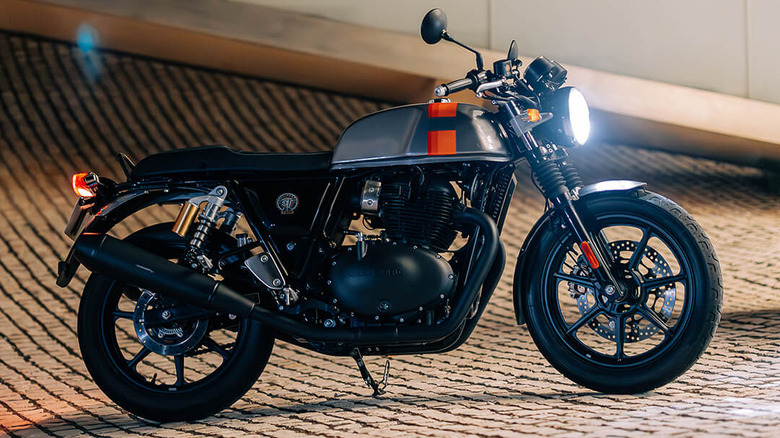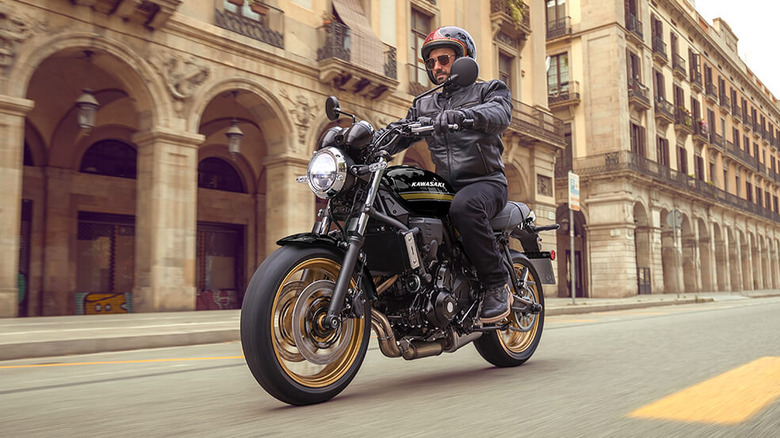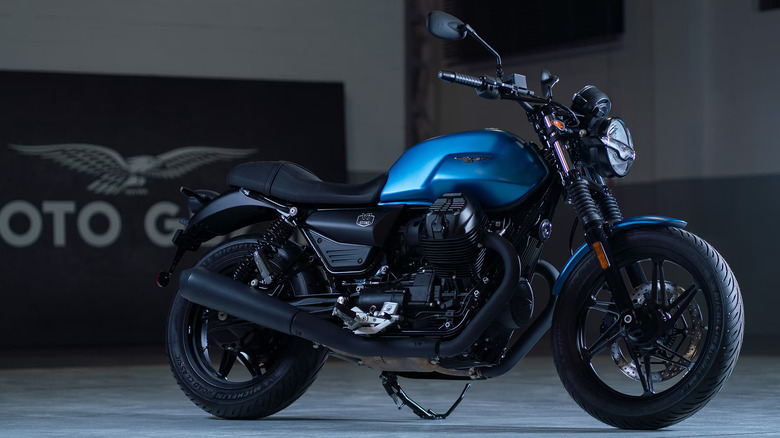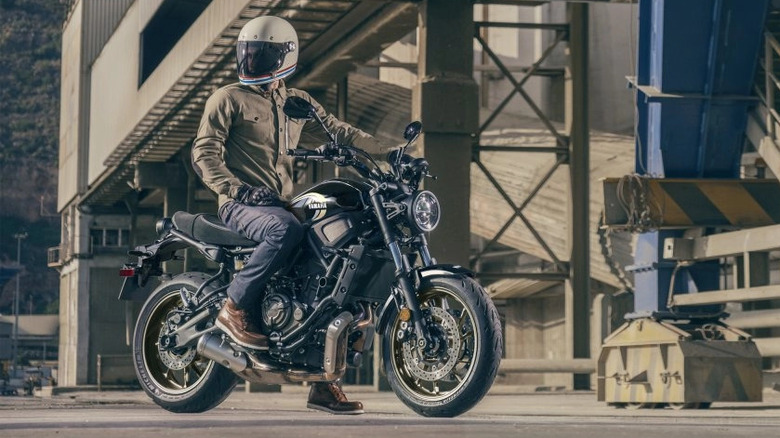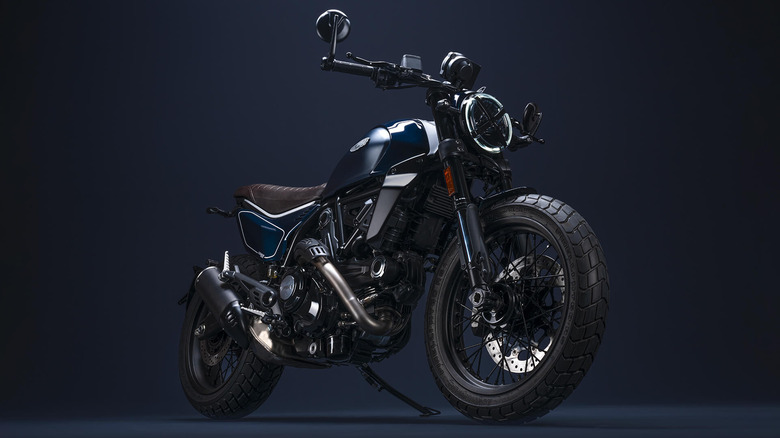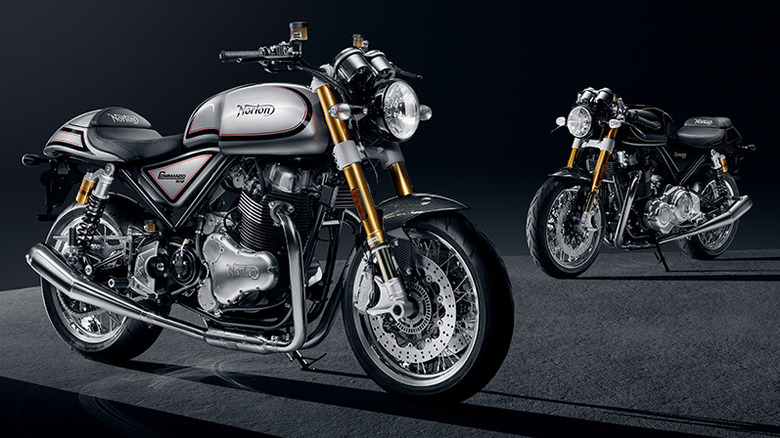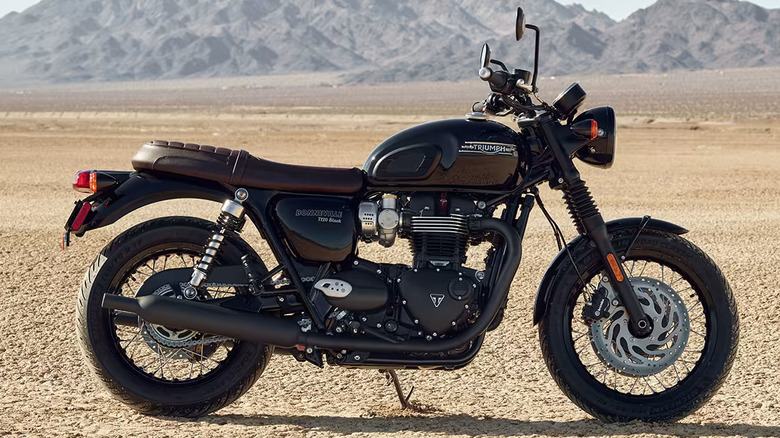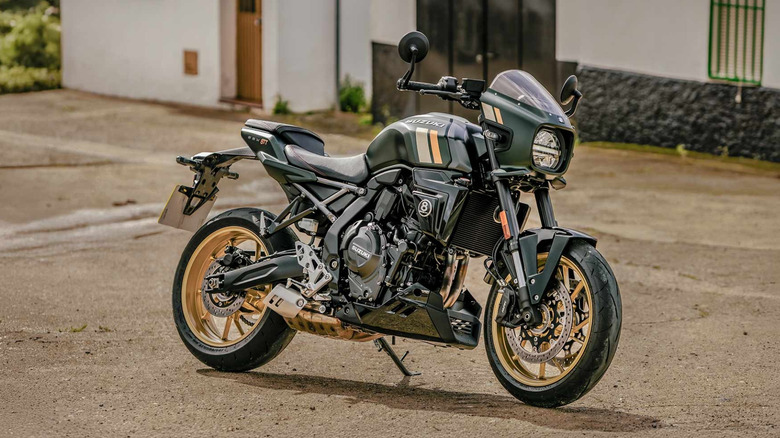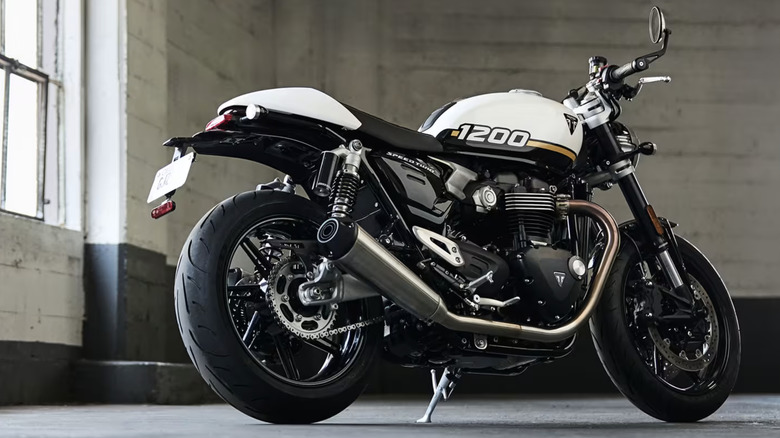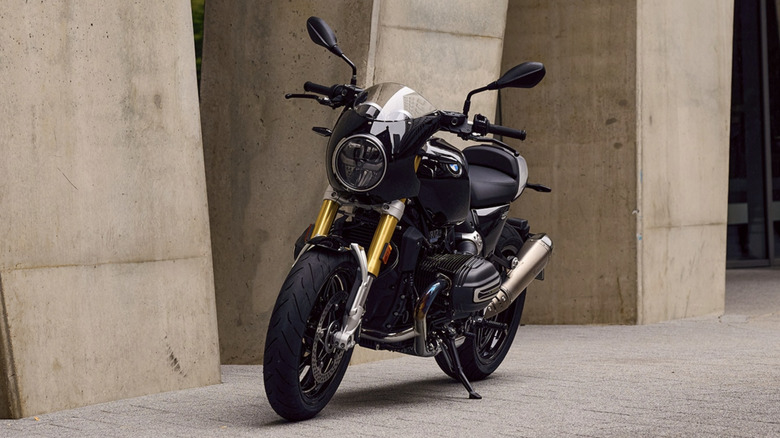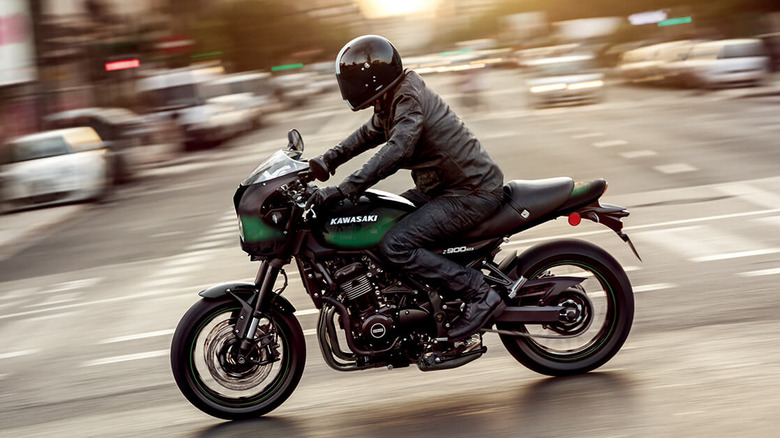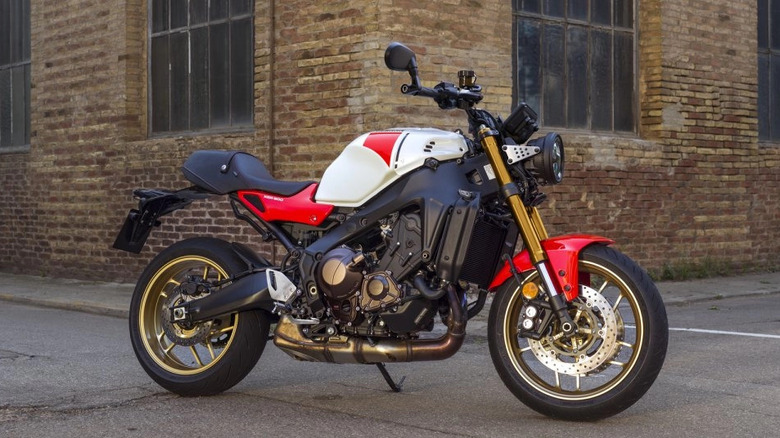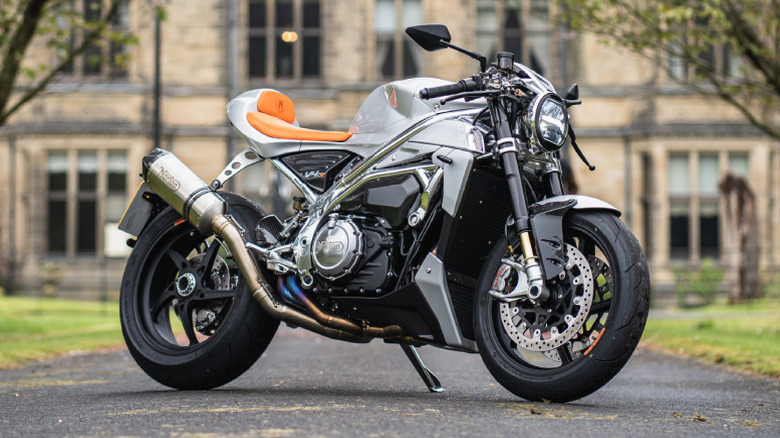13 Of The Most Powerful Café Racer Motorcycles, Ranked By Horsepower
What makes a café racer? In short, a combination of attitude, aesthetics, and customization. The bikes appeared in the 1950s and '60s, driven by the rebellious, rock and roll energy of the era. And now, some 70 years later, they're having a big resurgence. New café-style models are popping up from a variety of different motorcycle manufacturers. More than just a stylish copy of a bygone era, these new café bikes are seriously powerful.
The modern crop of café bikes benefit from the latest sport bikes, sharing powertrains and achieving astonishing output. They aren't as focused on an all-out racetrack experience (even though they have "Racer" in the name), but that hasn't stopped modern café bikes from exceeding power expectations while offering a big dose of nostalgia.
A few quick notes before we dive into this list of powerful café bikes: many motorcycle manufacturers don't list power figures for their bikes in the States. Where necessary, power figures have been sourced and converted from European spec sheets. Small differences in the tuning and equipment on these bikes may change between Europe and the US, but power levels will likely be similar regardless of country. Also, this isn't every variant of every top-powered café bike. We've tried to limit brand duplicates and engine duplicates where possible to showcase the overall popularity of the class.
Royal Enfield 650
It might be at the lowest spot on our list, but the Royal Enfield 650 (in its many trim levels) is one of the most representative versions of a café bike. It's simple, inexpensive, and can be modified or customized in a number of different ways. There are lots of different choices for Enfield 650 models, including the Continental GT, INT, Shotgun, and Bear. The Shotgun and Bear are a bit less café-racer styled, with the Bear oncoming equipped with knobby tires and the Shotgun more closely resembling a cruiser.
The INT is the entry-level model, but the Continental GT really plays up the café racer styling with lower-slung handlebars, rear foot pegs, and a more angular fuel tank cover. It truly looks the part, and with a starting price of $6,649 (plus destination fees), it's extra appealing to bikers on a budget.
Power for the Royal Enfield 650 line comes from an air-cooled, 648cc inline twin-cylinder engine that produces 46.8 hp and 38.5 lb-ft. It's a bit heavy considering its modest power, with a curb weight of 478 lbs (217 kg), but this remains an attractive proposition in the segment.
Kawasaki Z650RS
The Z650RS is a pretty modern motorcycle with significant power to back up its looks. Technically, the Z650RS falls under Kawasaki's heading of a "Retro Sport" motorcycle, and it does a pretty impressive job of pairing modern tech with classic looks. It's powered by a 649cc parallel-twin engine that produces 67 hp and 48.5 lb-ft. (You'll start to notice a pattern here that most bikes in this segment are powered by parallel-twin engines — it's extremely common.)
Currently, the Z650RS is only available in one trim and it comes standard with classic café looks along with an assist and slipper clutch, an LED headlight, and ABS. It has two analog gauges for the rider, both flanking a small LCD screen with important information like the fuel level, engine temperature, and a gear indicator. Curb weight, according to Kawasaki, is a scant 412 pounds, which should help the Z650RS feel relatively nimble. The Kawasaki's power and tech are reflected in the price, with a starting MSRP of $9,584 (including $685 destination fee). That's a big leap over the price of the Royal Enfield, but the power makes a similarly sizable jump.
Moto Guzzi V7
Don't be confused by the name; the Moto Guzzi V7 is not powered by a V7 engine. It is, however, powered by an 853cc V-Twin engine that makes some pretty healthy power. All three configurations of the V7 — the Stone, Sport, and Special — offer the same engine, which puts out 67.3 hp and 58.2 lb-ft. The Guzzi's V-twin configuration is a bit rare in the café bike class, with lots of its rivals offering power via parallel twins, which helps the Guzzi look and sound distinct in the segment.
Not including destination fees, the V7's price ranges from $9,690 on the base Stone up to $10,690 on the top Sport version. Tech features like traction control, a cornering ABS, and multiple riding modes help it feel modern in the face of the classic aesthetic, and the inclusion of cruise control as standard on all trims will make long-distance rides a bit easier. Available accessories include Bluetooth phone pairing, heated grips, and a tire pressure monitoring system.
Yamaha XSR700
Yamaha is known for its screaming
sport bikes like the R6 and the R1
, but it also has a limited lineup of what they call "Sport Heritage" motorcycles. The list of Sport Heritage bikes includes a few cruisers and two café-style bikes. The XSR700 is the smaller of the two café bikes but it's still powerful enough to get a spot on this list. The XSR700 gets its thrust from a 689cc parallel-twin engine that makes 72 hp and 49.4 lb-ft. It checks in at just 410 lbs, so it's plenty powerful enough for most riding scenarios.
The XSR has all the classic café styling cues, including a circular headlight, a circular taillight, and some bronze brightwork on 2025 models. A single circular gauge pod combines the classic circular shape with a legible digital readout that shows essential information like speed, fuel level, and RPM. The XSR700 isn't packed with much in the way of modern features or amenities, but it has a reasonable price for the package. MSRP for a new 2025 XSR700 is $9,199 (including $600 destination fee).
Ducati Scrambler
Technically, a scrambler isn't a café bike. If you get down into the nitty gritty of separating out genres and styles of motorcycles, a café racer is styled and built with pavement in mind, while a scrambler is meant to tackle a combination of street and dirt surfaces.
Knobby tires are usually a dead giveaway on scrambler bikes that they're focused on a different kind of performance. The styling of the two kinds of bikes is pretty similar, though, and Ducati says that the Scrambler Nightshift trim has a café racer attitude thanks to a few key aesthetic choices like the license plate location, the blacked-out wheels, and the minimalist lighting, so we'll let this one slide. (Plus, if you add some street-focused tires to your Ducati, few people will slice the differences that thin.)
The Ducati Scrambler Nightshift is powered by an 803cc L-twin engine that makes 73 hp and 48.1 lb-ft. It's relatively light at 401 lbs, and it offers several modern features like a 4.3-inch rider display, LED lighting, a USB port under the seat for charging your devices, and a quick shifter. Pricing for the Nightshift trim starts at $13,390 (including $995 destination fee), which puts it at the top of the Scrambler lineup, but other more-affordable versions of the Scrambler are also available.
Norton Commando 961
For a parallel-twin engine, the Norton Commando 961's powertrain is pretty big. If the name weren't a big enough clue, the engine is 961ccs (bordering on liter-bike territory) and it produces 76.8 hp and 59.7 lb-ft. That big power number is available in two different configurations, both of which fit the café racer mold. The first is the Commando 961 Sport with flat handlebars and a more upright riding position. For a bit more authenticity (and undoubtedly less comfort for long rides) the Commando 961 Café Racer drops the handlebars way down — right where they'd be if you were racing café bikes back in the 1960s, when the Commando got its start.
Either configuration looks the part of a proper café bike, with lots of aesthetically pleasing touches and an upscale feel. The Commando 961 is a mix of classic and new, using modern Brembo brakes and Öhlins suspension right alongside analog gauges. MSRP for the 961 Sport is £16,999 (which currently equals about $23,045). The café racer trim will cost you slightly more at £17,499 (about $23,723, currently).
Triumph Bonneville T120
At this point in the list, you might've wondered where all the Triumph bikes have been. After all, Triumph makes a ton of café-styled bikes that have big power, and their bikes are among the most reliable ever built. The Triumph 660 makes 81 hp and 47 lb-ft, which would out-power a few of the options listed already, but it's more café-adjacent with a lot of naked street bike styling cues. And we've already stretched the rules for the Ducati Scrambler, so why not include the 89-hp Triumph Scrambler 1200? It could probably be included, but we didn't want a list completely dominated by one manufacturer. So instead, we gave two spots on the list to Triumph, one of which is for the Bonneville T120 (you'll see another Triumph a few spots ahead).
The Bonneville T120 is powered by a hulking 1,200cc parallel-twin engine that makes 78.9 hp and 77.4 lb-ft. It's available in several different colors and configurations, appealing to the selectively stylish rider, but the style and power of the T120 don't come cheap. A standard black model has an MSRP of $21,890 (not including destination fee). Specialized paint like Triumph's stealth sapphire blue will cost an extra $1,200, and seemingly endless accessories take it from there, lending a customizable but costly nature to the big Bonneville.
Suzuki GSX-8TT
You're probably used to seeing the letters GSX placed before an R, especially when it comes after the word Suzuki. After all, the powerful Suzuki GSX-R (better known as the Gixxer) is one of the most popular sport bikes of all time. The new GSX-8T and 8TT, however, are purposefully styled as café bikes, leaving their sport-bike brethren behind. Both the GSX-8T and the GSX-8TT are powered by a 776cc parallel-twin engine, borrowed from the GSX-8S and GSX-8R, putting out the same amount of power: 81.7 hp and 57.5 lb-ft.
The 8TT offers a bit more café flair with a headlight cowl and some underbody panels meant to make it look extra sporty. Modern features like a USB-C charging port, a 5-inch rider screen, and a bi-directional quick shifter are all part of the package, too. The standard 8T model starts at $11,349 (including $600 destination fee), but you can get the headlight cowl and the underbody fairing for a little extra — the 8TT has an MSRP of $11,849. The 8TT also comes with gold wheels and some stylish tank stripes to top things off.
Triumph Speed Twin 1200
As mentioned earlier, there are a lot of bikes in Triumph's lineup that have a café racer aesthetic. Round headlights are a part of their design language and sleek, minimalist styling is present on a large percentage of the brand's motorcycles. The Speed Twin 1200, however, available in a few different configurations, is one of the most powerful bikes in their lineup. Like the T120, the Speed Twin 1200 uses a 1,200cc parallel-twin engine, but in this case the output is much higher: 103.5 hp and 82.6 lb-ft.
With a starting price of $22,990, the standard Speed Twin has the basics covered. It has USB charging for your device, traction control, two riding modes, and basic suspension components. The Speed Twin RS, however, adds Brembo front brake calipers, Öhlins suspension components, a quick shifter, an upgraded seat, and an extra Sport riding mode. It has an MSRP of $26,990. Crossing over into the three-digit horsepower territory, it turns out, comes at a steep price.
BMW R 12 nineT / R 12 S
Adventure bikes, track-dominating sport bikes, angular street naked models, and continent-crossing touring bikes are all horses in the BMW-bike stable. BMW even offers a few cruisers that will go head-to-head with the best Indian and Harley-Davidson models you can think of. Their R 12 bikes are where you'll find classic café styling, though, most notably with the R 12 nineT and R 12 S. Both bikes are powered by an impressive 1,170cc two-cylinder boxer engine that makes 109 hp and 85 lb-ft. BMW has even gone as far as listing the top speed (an uncommon occurrence with motorcycles), an impressive 134 mph.
The R 12 nineT is one of the prettiest bikes in its class, with a seriously stylish single-sided swingarm, classic gold front forks, and several aesthetic upgrades available. Style comes at a price, however, with a base MSRP of $17,940 (including $695 destination fee). The R 12 S adds wire spoke wheels, a special paint job, unique fairings, cruise control, heated grips, and some other upgrades, for a starting price of $22,285.
Kawasaki Z900RS
The Kawasaki Z900RS is one of the very few motorcycles on this list that has four cylinders, and it's especially rare in that it has four cylinders in a row (also known as an inline four-cylinder engine). The Z900RS is available in three different configurations: base, Café, and SE. All three models use the same 948cc engine (the same engine used in the seriously swift Z900) that generates 110 hp and 72.3 lb-ft. The base Z900RS gets a pretty short equipment list; it has the café styling you expect, traction control, and not much else. It's a basic machine like most cafe bikes should be, and it has a starting price of $13,489.
The mid-level Z900RS Café gets a headlight cowl that should help deflect some wind and bugs, a tuned exhaust, and some special tank graphics. All that for an extra $250 is a pretty good deal. The top-level Z900RS SE really steps things up with Öhlins suspension, Brembo front brakes, gold wheels and gold front forks, and a riding position that's a bit more relaxed. With an MSRP of $14,989, it's a bit more expensive than the base models, but you get a lot of equipment for the extra money. Regardless of which trim you pick, you get one of the most powerful café bikes on the market.
Yamaha XSR900
In a class jam-packed with two-cylinder options, the Yamaha XSR900 is an odd duck, literally. It uses an inline three-cylinder 890cc engine – one of the very few three-cylinders on the market and the only one on our list. The three-cylinder engine (also known as the CP3) is the same powerplant that is used in Yamaha's new full-fairing sport bike, the R9. In the XSR900, the CP3 engine produces 117 hp and 68.5 lb-ft. That's enough power to outclass several sport bikes.
The XSR checks off all the café styling prerequisites, too: a circular headlight, low and flat handlebars, gold wheels, and lots of exposed metal elements. The large 5-inch rider display, a quick shifter, USB-C charging point, and cruise control are all standard equipment. When you consider its prodigious power, all the gear that comes as a part of the package, and the fact that its rivals can go for nearly twice as much, the XSR900's starting price of $11,224 seems like a relative bargain.
Norton V4CR
Built on the same underpinnings as the V4SV sport bike, the Norton V4CR is a seriously-powerful machine, no matter what you put it up against. It's impressive even compared to the most powerful supersport bikes on the market. The V4CR (the CR stands for Café Racer, of course), is powered by a 1,200cc V4 engine that produces 185 hp and 92 lb-ft. The tubular chassis is made from aluminum to keep things as light as possible, and with a curb weight of 445 lbs (204kg), it seems the high-end materials have done their job. That weight might seem hefty for a middle-weight sport bike, but when you consider the large V4 engine and the massive power output, it's pretty light.
Don't confuse the minimalist aesthetic with minimal equipment on this one — the V4CR has all sorts of gear and modern tech worth mentioning. For stopping power, the V4CR gets Brembo brakes. Öhlins suspension components soak up the bumps and a quick-shift system helps you move up and down easily through the gears. A 6-inch rider display shows all the necessary display items, while carbon fiber bodywork and a single-sided swing arm give the V4CR stunning curb appeal. A starting price of £42,000 translates to roughly $56,940 at the time of writing, which is certainly steep, but worth it when you consider the V4CR's power, equipment, and hand-built quality.

